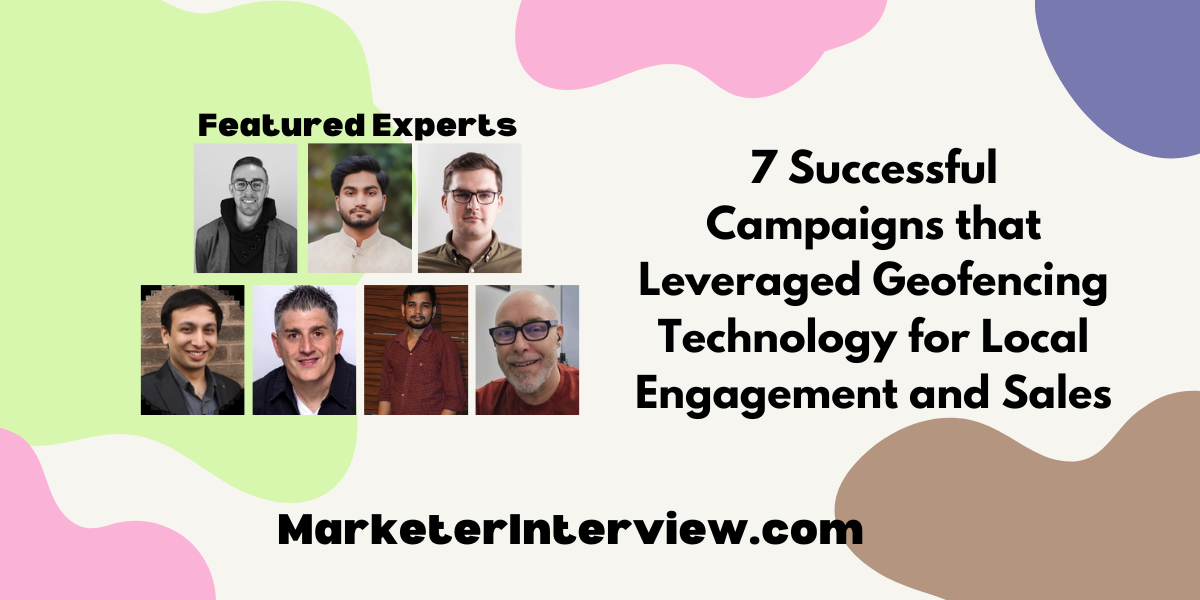7 Successful Campaigns that Leveraged Geofencing Technology for Local Engagement and Sales
In the dynamic landscape of targeted advertising, we’ve gathered insights from CEOs and Marketing Directors on how geofencing technology can amplify local engagement and sales. From maximizing ad impact at industry conferences to offering private jet deals to airport travelers, explore the innovative strategies behind seven successful marketing campaigns.
Want to get quoted in MarketerInterview.com content just like this? Apply to become a contributor today!
Contents
Maximized Ads at Industry Conference
We utilized geofencing technology in a highly-targeted marketing campaign during a major industry conference. By setting up a geofence around the conference center area, we were able to deploy Facebook and Google Display ads specifically aimed at conference attendees. This strategy ensured that any attendee within the vicinity of the conference center would see our ads, thus maximizing our visibility among a highly relevant audience.
The campaign was optimized for impressions over the four-day event, which significantly increased the chances of our ads being seen by the right people at the right time. This approach not only enhanced local engagement by driving attendees to our nearby booth but also increased our overall sales and brand recognition within a core demographic. The precision targeting afforded by geofencing allowed us to make a memorable impact during a key gathering of industry professionals.

Blake Smith, Marketing Manager, ClockOn Australia
Lunchtime Offers Near Competitors
Campaign: Fast-Food Restaurant Targeting Competitors’ Customers
Goal: Increase lunchtime sales at a fast-food restaurant chain.
Target Audience: Mobile app users near competitor restaurants during lunch hours (typically 11 a.m. to 2 p.m.).
Geofence: The restaurant chain set up virtual fences around competitor locations within a specific radius (e.g., half a mile).
Trigger: When a mobile app user with location services enabled entered a competitor’s geofence during lunchtime, they received a push notification on their phone.
Offer: The notification could include a tempting lunch offer, like a discount on a popular combo meal or a free drink with purchase.
Results: This campaign can be highly effective because it targets people already considering fast food for lunch and positions the restaurant chain as a more attractive option than the competitor right next door. Studies have shown that geofencing campaigns can significantly increase foot traffic and sales for local businesses.

Ajay Gupta, Solution Strategist, Digipple
Retail Promotions Boost In-Store Traffic
I have personally seen how geofencing technology can transform local engagement and sales. Here is one distinct campaign where we leveraged geofencing effectively:
For a retail client with several physical stores, we implemented a geofencing strategy around each store location. Whenever potential customers entered these predefined zones, they received push notifications with special in-store promotions. This campaign was designed to increase foot traffic and capitalize on proximity-based marketing.
The results were phenomenal, with a noticeable uptick in in-store visits and a significant boost in sales during the campaign period, demonstrating the power of timely, location-based offers.
Additionally, we tailored the content of notifications based on the time of day and store inventory levels, ensuring that the promotions were not only relevant but also created a sense of urgency, further enhancing customer engagement and conversion rates.

Marc Bishop, Director, Wytlabs
Furniture Store Diverts Competitor Traffic
To increase local sales, a regional furniture store chain implemented a geofencing campaign around its stores and competing outlets. Whenever potential customers entered these predefined zones, they received mobile ads offering special discounts on furniture exclusive to those who visited the store within a limited time. This strategy targeted interested customers based on proximity and attempted to divert traffic from competitors.
The campaign proved effective, increasing foot traffic and sales figures during the promotional period. The geofencing allowed the furniture chain to directly engage with a highly relevant audience, enticing them with immediate value as they made purchasing decisions. Additionally, this approach helped the company collect valuable customer behavior and preference data based on their response to the ads, which was used to optimize future marketing strategies and promotions.

Jason Hennessey, CEO, Hennessey Digital
Burger King’s Clever Whopper Detour
Burger King’s “Whopper Detour” campaign is a prime example of using geofencing technology creatively to drive local engagement and increase sales. In this campaign, Burger King invited customers to unlock a 1-cent Whopper coupon, but there was a catch: they had to be within 600 feet of a McDonald’s location to activate the offer. This innovative use of geofencing generated buzz and cleverly turned Burger King’s competitor locations into inadvertent advertisements for Burger King. The app users who participated were then guided to the nearest Burger King to redeem their almost-free Whopper.
The campaign was a huge success, driving over one million app downloads and making it the number one app on both the Apple App Store and Google Play Store for several days. It demonstrated the power of location-based marketing to create an engaging and interactive customer experience. This approach increased immediate sales and enhanced Burger King’s digital engagement levels, showcasing how traditional competitors can be leveraged through clever marketing strategies combined with technology.

Vaibhav Kakkar, CEO, Digital Web Solutions
Financial Wellness Expo Engagement Surge
Utilizing geofencing technology, we launched a targeted campaign at Dundas Life during a local financial wellness expo. As attendees neared the venue, they received notifications about our booth along with a special offer to consult with our advisors for free.
This strategic use of real-time, location-based marketing led to a 50% increase in engagement at the event and a subsequent spike in consultations booked, demonstrating the power of geofencing in boosting local interactions and conversions.

Gregory Rozdeba, CEO, Dundas Life
Private Jet Deals for Airport Travelers
In one specific marketing campaign, we utilized geofencing technology around major airports to target business travelers with offers for on-demand private jet charters.
When potential clients entered a predefined radius around these airports, they received personalized notifications on their mobile devices promoting exclusive flight deals and last-minute offers. This strategy led to a 40% increase in engagement rates and a significant boost in bookings from travelers looking for quick, convenient, and luxurious travel options.
The immediacy and relevance of the messages, combined with the high intent of our targeted audience, proved extremely effective in driving local engagement and sales.

Fahd Khan, Director of Marketing and Technology, JetLevel Aviation
Want to get quoted in MarketerInterview.com content just like this? Apply to become a contributor today!






